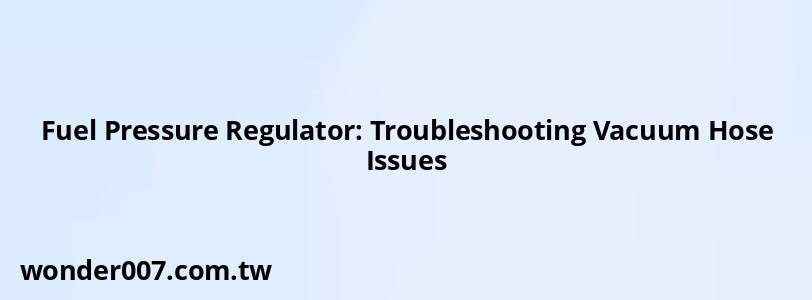Fuel Pressure Regulator: Troubleshooting Vacuum Hose Issues
159
0

When the vacuum hose connected to the fuel pressure regulator is disconnected, it can lead to various engine performance issues. This situation is critical for vehicle owners and mechanics who need to understand the implications and solutions.
Understanding the Fuel Pressure Regulator
The fuel pressure regulator controls the fuel pressure in the fuel system. It ensures that the engine receives a consistent fuel supply, which is essential for optimal performance. The regulator uses a vacuum hose to adjust fuel pressure based on engine load and demand.
Symptoms of a Disconnected Vacuum Hose
If the vacuum hose is disconnected, you may notice several symptoms:
- Poor engine performance: The engine may hesitate or stall due to inconsistent fuel delivery.
- Increased fuel consumption: The vehicle may consume more fuel than usual.
- Check engine light: The vehicle's onboard diagnostics may trigger a warning light.
- Rough idling: The engine may idle unevenly or shake.
Potential Causes of Disconnection
Several factors can cause the vacuum hose to disconnect:
- Wear and tear: Over time, hoses can become brittle and break.
- Improper installation: If the hose was not secured correctly, it could easily come loose.
- Environmental factors: Heat and exposure to chemicals can degrade rubber hoses.
Solutions for Reconnecting the Vacuum Hose
To resolve issues caused by a disconnected vacuum hose, follow these steps:
- Inspect the hose: Check for cracks, wear, or damage.
- Reconnect securely: Ensure that the hose fits snugly onto both the regulator and intake manifold.
- Replace if necessary: If the hose is damaged, replace it with a new one.
- Test the system: After reconnecting, start the engine and check for any leaks or issues.
Preventive Measures
To prevent future disconnections:
- Regularly inspect hoses for signs of wear.
- Ensure proper installation during repairs or replacements.
- Avoid exposing hoses to extreme temperatures or chemicals.
FAQs About Fuel Pressure Regulator Vacuum Hoses
- What happens if my vacuum hose is disconnected?
A disconnected vacuum hose can lead to poor engine performance, increased fuel consumption, and potential engine stalling. - How do I know if my fuel pressure regulator is faulty?
Symptoms include rough idling, poor acceleration, and a check engine light. - Can I drive with a disconnected vacuum hose?
It is not recommended as it can cause significant engine performance issues.
---
Related Posts
-
Mini Cooper Key Fob: Troubleshooting Unlock Issues
28-01-2025 • 170 views -
Hyundai Accent Tire Pressure Light Reset Guide
30-01-2025 • 279 views -
ABS Light On in 2007 Toyota Camry: Troubleshooting Guide
28-01-2025 • 177 views -
Chevy AC Compressor High Pressure Switch Location
26-01-2025 • 180 views -
Kia Forte Backup Camera Troubleshooting Guide
30-01-2025 • 243 views
Latest Posts
-
Are O2 Sensors Covered Under Warranty
01-02-2025 • 378 views -
2015 Chevy Traverse AC Recharge Port Location
01-02-2025 • 417 views -
Rear Brake Caliper Piston Won't Compress
01-02-2025 • 361 views -
How To Turn Off Paddle Shifters Mercedes
01-02-2025 • 387 views -
Power Steering Fluid Leak On Passenger Side
01-02-2025 • 461 views
Popular Posts
-
Power Steering and ABS Light On: Causes and Solutions
27-01-2025 • 649 views -
Hino Warning Lights: Understanding Dashboard Alerts
26-01-2025 • 794 views -
EPC Light: Understanding Causes and Solutions
26-01-2025 • 1065 views -
V12 Engine Costs: What You Need to Know
26-01-2025 • 688 views -
Toyota Hiace: Fuel Efficiency Insights for 2025
26-01-2025 • 645 views
